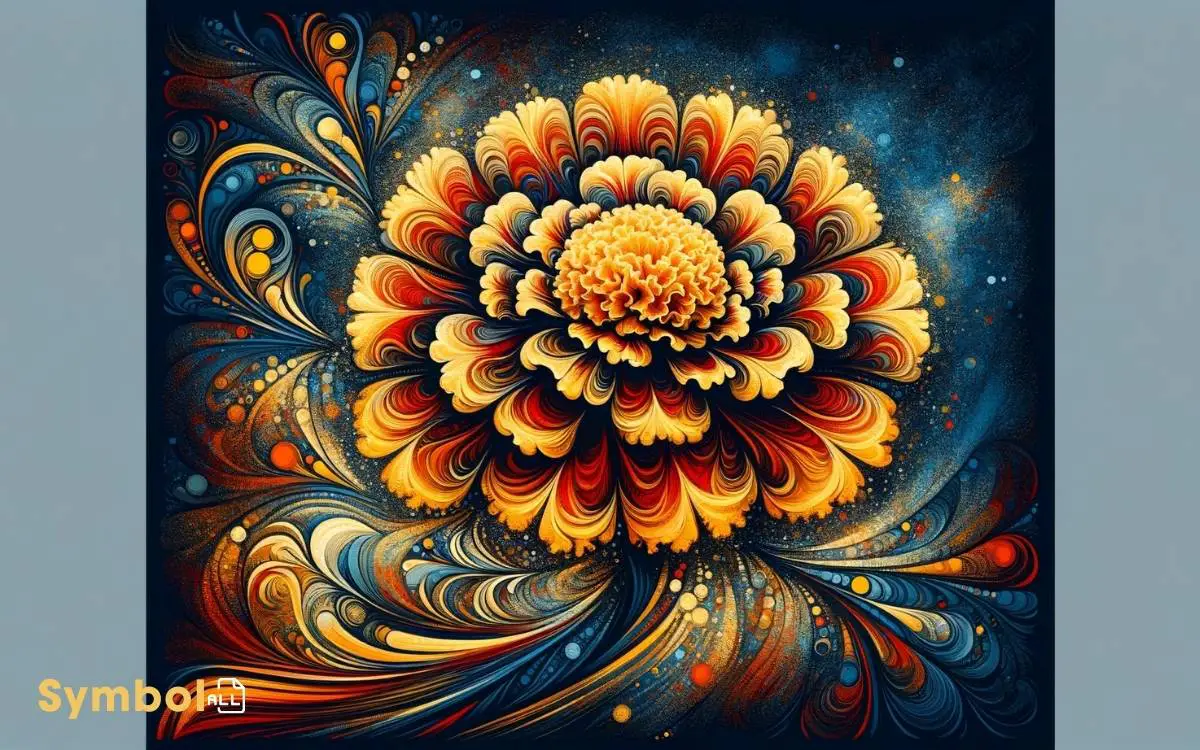What Does the Marigold Flower Symbolize? Resilience!
Marigolds symbolize a blend of resilience, spiritual bridging, and healing. Cultivated first by the Aztecs for their believed supernatural powers, their pigments contain compounds like lutein, contributing to their vivid colors and potential health benefits.
In Mexico, you’ll find them guiding spirits during Día de los Muertos. Hindus and Christians use marigolds to signify prosperity and the endurance of the Virgin Mary, respectively.
Additionally, their colors speak volumes; yellow signifies warmth, orange radiates enthusiasm, and white marks new beginnings.
Marigolds don’t just dazzle with their hues; they carry profound meanings across cultures and religions. Uncover the full breadth of this flower’s significance to truly appreciate its role in rituals and daily life.

Key Takeaways
Historical Significance
Marigolds, known scientifically as Tagetes, have played a pivotal role in cultural and religious ceremonies across the world for centuries, embodying symbols of passion and creativity.
Your inquisitiveness about these vibrant flowers reveals a rich history deeply rooted in various civilizations.
Originating in the Americas, marigolds were first cultivated by the Aztecs, who believed these flowers possessed supernatural powers and used them in ritualistic practices for protection and healing.
As Europeans arrived in the New World, they were captivated by the marigold’s vivid colors and robust nature, quickly incorporating them into their own medicinal and horticultural practices.
Scientifically, marigolds have been studied for their unique compounds, such as lutein, which contribute to their bright hues and potential health benefits. This historical context highlights their enduring significance beyond mere aesthetic appeal.
Cultural Interpretations
Across various cultures, people have attributed a plethora of meanings and symbolisms to marigolds, reflecting their significance in societal rituals and traditions.
In Mexico, marigolds are pivotal in Día de los Muertos celebrations, believed to guide the spirits of the deceased with their vibrant colors and pungent scent.
Hindu ceremonies often incorporate marigolds as symbols of prosperity and vitality, adorning temples and participants in religious festivals.
In certain Christian denominations, marigolds are associated with the Virgin Mary, representing her pain and endurance, hence often used in events commemorating her life.
These cultural interpretations, deeply rooted in historical and religious contexts, demonstrate the marigold’s multifaceted role as more than just a flower, but a bridge between the living and spiritual worlds, encapsulating themes of life, death, and rebirth.
Color Meanings
Exploring the domain of marigold hues, you’ll find each color embodies a unique significance, grounded in scientific analysis and cultural research.
The vibrant yellow marigolds symbolize warmth and creativity, reflecting the sun’s energy. This association, supported by color psychology, suggests that yellow hues stimulate mental activity and promote cheerfulness.
Orange marigolds, radiating enthusiasm and success, stand as a proof to the flower’s ability to inspire positive interaction and vibrant life, according to chromotherapy studies.
The lesser-known but equally significant white marigold carries a message of purity and new beginnings, offering a contrast to its colorful counterparts by embodying potential and clarity.
Each color, accordingly, serves as a conduit for specific emotions and messages, deeply rooted in empirical research and cultural symbolism.
Religious Connections
Delving into the spiritual domain, you’ll discover marigold flowers hold profound religious significance, historically rooted in rituals and worship practices across various cultures.
| Culture | Significance | Usage |
|---|---|---|
| Hinduism | Represents purity, brightness, and the energy of the sun, symbolizing a heart open to the divine light. | Used in religious ceremonies and festivals, like Diwali. |
| Catholicism | Associated with the Virgin Mary, symbolizing pain and suffering, as well as respect and remembrance. | Placed on altars and graves during All Souls’ Day. |
| Aztec Tradition | Used in rituals to honor the dead, believing marigolds guide the spirits to their altars. | Integral in Day of the Dead celebrations. |
This connection to divinity and the afterlife highlights the marigold’s role in bridging the earthly with the spiritual.
Modern Symbolisms
Today, marigold flowers embody a range of modern symbolisms, reflecting contemporary cultural and emotional significances backed by recent studies.
Research indicates that marigolds are now frequently associated with resilience and survival, mirroring their ability to thrive in harsh environments.
You’ll find that their vibrant orange and yellow hues are linked to warmth, optimism, and the energy of the sun, promoting a positive outlook on life.
Additionally, scientific investigations have revealed their potent antimicrobial properties, leading to a symbol of healing and protection against ailments.
These modern interpretations are grounded in empirical evidence, showcasing marigolds as not just ornamental plants but as entities carrying deep-seated meanings relevant to today’s societal and individual challenges.
Can the Marigold Flower Symbolize Both Resentment and Resilience?
The marigold flower can symbolize both feelings of resentment and anger, as well as resilience. In some cultures, the flower is associated with negative emotions, while in others, it represents strength and endurance. This duality makes the marigold a complex and versatile symbol in various contexts.
Conclusion
To conclude, you’ve delved into the rich tapestry of meaning behind the marigold flower, from its historical roots to its diverse cultural interpretations, color significances, religious connections, and contemporary symbolisms.
Remarkably, research indicates that marigolds cover over 50 species worldwide, underscoring their global significance in various traditions and practices.
This statistic highlights the marigold’s universal appeal and its enduring symbolism in conveying messages of grief, despair, and yet, hope and warmth across cultures, showcasing its unique ability to bridge diverse human experiences through its vivid hues and enduring presence.






